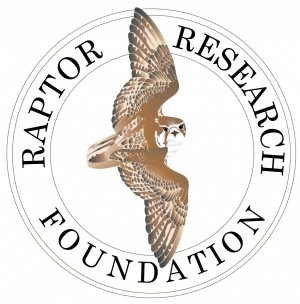Location
The Raptor Research Foundation (RRF) is a non-profit scientific society whose primary goal is the accumulation and dissemination of scientific information about raptors.
Following those horrific decades from the 1930s to the 1950s when most folks shot and poisoned raptors as “good-for-nothing chicken-hawks”, bird of prey populations were next subjected to a barrage of chemical abuses ranging from both the direct and indirect effects of pesticides and industrial by-products, e.g. organochlorines and organophosphates, polybrominated biphenyls, heavy metals and rodenticides. Unable to reproduce their numbers, several raptor species, e.g. peregrine falcons and bald eagles, teetered on the brink of extinction in the early 1970s. But it was not all bad news – there were also people out there who cared, i.e. falconers, academics, educators, rehabilitators, government biologists. And together, they organized an “army” to help birds of prey. That army today is called the Raptor Research Foundation (RRF).
Members:
Resources
Displaying 1 - 5 of 7Effect of Supplemental Feeding on the Known Survival of Reintroduced Aplomado Falcons: Implications for Recovery
The northern Aplomado Falcon (Falco femoralis septentrionalis) inhabited the inland and coastal grasslands of Texas, New Mexico, and Arizona until about 1930, when records of aplomados in the United States decreased. In 1986, the species was classified as endangered under the Endangered Species Act. Among other recovery efforts, 102 birds were released from 2006 through 2011, in its former range in New Mexico at the Armendaris Ranch in the southâcentral portion of the state. To promote their survival, an extended supplemental feeding program was conducted.
Daytime Habitat Selection by Resident Golden Eagles (Aquila chrysaetos) in Southern Idaho, U.S.A
Energy and other anthropogenic development are increasing throughout the range of Golden Eagles (Aquila chrysaetos) in western North America, and both private and government agencies have expressed concern about indirect and direct effects on Golden Eagles. To facilitate sustainable development and reduce risk to Golden Eagles, the U.S. Fish and Wildlife Service has established guidelines to assist developers in project planning and siting. A major component of environmental impact assessment is documenting Golden Eagle spatial use near a project site before development.
Factors Influencing Reproductive Success Of Ferruginous Hawks in the Uintah Basin, Utah
We examined factors that potentially influenced reproductive success in Ferruginous Hawks (Buteo regalis) in the Uintah Basin, Utah, and determined whether oil and gas well development was one of those factors. For three breeding seasons (2002â2004), we measured the number of nestlings, fledglings, and dispersed young that were produced by pairs of Ferruginous Hawks nesting within 2365 km² managed by the Bureau of Land Management.
Factors Associated with Flammulated Owl and Northern Saw-Whet Owl Occupancy in Southern Idaho
Spatially explicit models depicting species occupancy offer a useful conservation tool for land managers. Using occurrence data collected in 2009 and 2010 from the Boise National Forest, Idaho, we developed distribution models for Flammulated Owls (Psiloscops flammeolus) and Northern Saw-whet Owls (Aegolius acadicus) to explore associations between habitat factors and owl occupancy. We then spatially applied these models in a Geographic Information System.
Raptor Presence Along an UrbanâWildland Gradient: Influences of Prey Abundance and Land Cover
Native animals are affected differently by urbanization. Some species respond favorably and thrive in human-dominated landscapes, but others are extirpated. Raptors are often sensitive to changes in land cover and prey abundance. We therefore used a combination of broadcast surveys and incidental observations while spot-mapping to evaluate the influences of these two variables on the presence of raptors at 21 sites from 2004â2008 along an urban-to-wildland gradient in western Washington, U.S.A.


